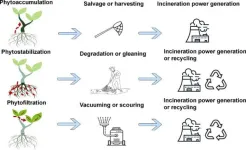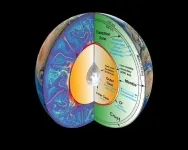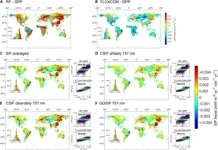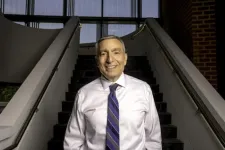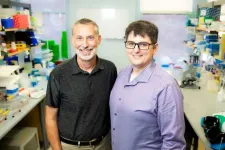(Press-News.org) A team led by Jose Onuchic at Rice University and Paul Whitford at Northeastern University, both researchers at the National Science Foundation Physics Frontiers Center at the Center for Theoretical Biological Physics (CTBP) at Rice, has made a discovery in the fight against severe acute respiratory syndrome coronavirus-2 (SARS-CoV-2), the virus responsible for COVID-19.
The team, in partnership with an experimental effort led by Yale University researchers Walter Mothes and Wenwei Li, has uncovered new insights into how the virus infects human cells and how it can be neutralized. Their findings were published in the journal Science on Aug. 15.
SARS-CoV-2 uses its spike protein to attach to the angiotensin-converting enzyme 2 on human cells, initiating a process that allows it to enter the cell. The spike protein has two main parts: the S1 domain, which varies greatly among different strains of the virus, and the S2 domain, which is highly conserved across different coronaviruses. This similarity makes the S2 domain a promising target for vaccines and therapies that could work against many virus strains.
By combining simulations and theoretical predictions with structural information from their experimental collaborators, including initial and final configurations as well as intermediate states during the viral invasion, the researchers obtained a detailed picture of the infection process at an atomic level.
“Understanding these intermediate states of the spike protein creates new opportunities for treatment and prevention,” said Onuchic, the Harry C. and Olga K. Wiess Chair of Physics, professor of physics and astronomy, chemistry and biosciences and co-director of CTBP. “Our work demonstrates the importance of combining theoretical and experimental approaches to tackle complex problems such as viral infections.”
Using an advanced imaging technique called cryo-electron tomography, the experimental researchers at Yale captured detailed snapshots of the spike protein as it changes during the fusion process.
They discovered antibodies targeting a specific part of the S2 domain, called the stem-helix, which can bind to the spike protein and stop it from refolding into a shape necessary for fusion. This prevents the virus from entering human cells.
“Our study provides a detailed understanding of how the spike protein changes shape during infection and how antibodies can block this process,” Onuchic said. “This molecular insight opens up new possibilities for designing vaccines and therapies targeting a wide range of coronavirus strains.”
The researchers used a combination of theoretical modeling and experimental data to achieve their findings. By combining simulations of the spike protein with experimental images, they captured intermediate states of the protein that were previously unseen. This integrated approach allowed them to understand the infection process at an atomic level.
“The synergy between theoretical and experimental methods was crucial for our success,” said Whitford, a professor in the Department of Physics at Northeastern. “Our findings highlight new therapeutic targets and strategies for vaccine development that could be effective against most variants of the virus.”
The team’s discovery is significant in the ongoing efforts to combat COVID-19 and prepare for future outbreaks of related viruses. By targeting the conserved S2 domain, scientists can develop vaccines and therapies that remain effective even as the virus mutates.
“This research is a step forward in the fight against COVID-19 and other coronaviruses that may emerge in the future,” said Saul Gonzalez, director of the U.S. National Science Foundation’s Physics Division. “Understanding the fundamental physical workings within intricate biological mechanisms is essential for developing more effective and universal treatments that can protect our health and save lives.”
This work was supported by the National Science Foundation, National Institutes of Health, Canadian Institutes of Health Research, Canada Research Chairs and Welch Foundation.
Other researchers include Michael Grunst and Zhuan Qin at the Department of Microbial Pathogenesis and Shenping Wu at the Department of Pharmacology at Yale; Esteban Dodero-Rojas at CTPB; Shilei Ding, Jérémie Prévost and Andrés Finzi at the Centre de Recherche du CHUM; Yaozong Chen and Marzena Pazgier in the Infectious Disease Division in the F. Edward Hebert School of Medicine at Uniformed Services University of the Health Sciences; and Yanping Hu and Xuping Xie in the Department of Biochemistry and Molecular Biology at the University of Texas Medical Branch at Galveston.
Video asset: https://vimeo.com/997846840/a428930caa?share=copy
END
Researchers make breakthrough in fight against COVID-19
2024-08-16
ELSE PRESS RELEASES FROM THIS DATE:
Methamphetamine-involved psychiatric hospitalizations have increased, study says
2024-08-16
AURORA, Colo. (August 16, 2024) – A new study, out now in Drug and Alcohol Dependence, that details trends among psychiatric hospitalizations between 2015-2019 finds that while most hospitalizations did not involve any substances, methamphetamine-related hospitalizations have increased while overall number of psychiatric hospitalizations remained stable.
Additionally, researchers detail that psychiatric hospitalizations caused by methamphetamine use were highest in the Mountain West region but were also shifting geographically. “Rates of ...
Green warriors: plants on the frontline against microplastics
2024-08-16
In an innovative ecological article, researchers have unveiled the potential of phytoremediation to curb microplastic pollution. This approach leverages natural plant processes to absorb and diminish micro and nanoplastics, offering a viable solution for managing environmental plastic pollution. This viewpoint advocates utilizing plant life as an effective tool against the widespread issue of plastic contamination in ecosystems.
With escalating concerns about the enduring impact of plastic waste, phytoremediation emerges as a promising solution. This method utilizes plants ...
Decoding mysterious seismic signals
2024-08-16
For the decades since their discovery, seismic signals known as PKP precursors have challenged scientists. Regions of Earth’s lower mantle scatter incoming seismic waves, which return to the surface as PKP waves at differing speeds.
The origin the precursor signals, which arrive ahead of the main seismic waves that travel through Earth’s core, has remained unclear, but research led by University of Utah geophysicists sheds new light on this mysterious seismic energy.
PKP precursors appear to propagate from places deep below North America and the western Pacific and possibly bear an association with “ultra-low velocity zones,” thin layers ...
Green light for accurate vegetation research: new evaluation of global SIF datasets
2024-08-16
A recent study has pinpointed the top-performing solar-induced chlorophyll fluorescence (SIF) products for precise global monitoring of photosynthesis and vegetation dynamics. By thoroughly evaluating eight widely-used SIF datasets, the research team identified Global OCO-2 SIF (GOSIF) and Contiguous Solar-Induced Fluorescence (CSIF) as leading tools for estimating gross primary productivity (GPP) and forecasting key phenological stages. These findings provide crucial direction for scientists aiming to enhance global vegetation ...
Mount Sinai researchers discover novel nanoparticles in blood with potential to transform cancer diagnosis
2024-08-16
New York, NY [August 16, 2024]—Scientists at the Icahn School of Medicine at Mount Sinai have identified a new class of RNAs packed into tiny particles known as extracellular vesicles (EVs) that could revolutionize how cancer and other diseases are diagnosed. The team found that these molecules undergo changes when cancer is present, suggesting their potential as biomarkers for detecting prostate cancer or as targets for therapy. The work, led by Navneet Dogra, PhD, Edgar Gonzalez-Kozlova, PhD, Tzu-Yi Chen, PhD, ...
Underground event marks excavation completion on colossal caverns for underground neutrino laboratory, DUNE
2024-08-16
Lead, SD (Aug. 15, 2024) — A ribbon-cutting event was held today at the Sanford Underground Research Facility (SURF) in Lead, S.D. to mark the completion of excavation work for the Long-Baseline Neutrino Facility/Deep Underground Neutrino Experiment (LBNF/DUNE), an international project led by the U.S. Department of Energy’s Fermi National Accelerator Laboratory. The “Into the Depths of Discovery” event, hosted by Fermilab and the South Dakota Science and Technology Authority (SDSTA), was attended by supporters of the three-year excavation of the caverns, including state and federal leaders as well as officials from the Department of Energy.
“Today ...
Exposing myths about ballot collection on Native American reservations
2024-08-16
Third-party collection of mail-in ballots has helped rural residents and those with disabilities to vote, yet the practice has become contentious and the target of laws aimed at restricting it.
Critics claim the process is vulnerable to fraud and manipulation.
But new research from the University of Utah’s College of Social & Behavioral Science tells a different story. Ballot collection is more accurately characterized as a pathway for legitimate voter participation, according to a study published last month. Authors Daniel McCool, a professor emeritus in the Department of Political Science, and Weston McCool, a ...
New twist on synthesis technique developed at Rice promises sustainable manufacturing
2024-08-16
James Tour’s lab at Rice University has developed a new method known as flash-within-flash Joule heating (FWF) that could transform the synthesis of high-quality solid-state materials, offering a cleaner, faster and more sustainable manufacturing process. The findings were published in Nature Chemistry on Aug. 8.
Traditionally, synthesizing solid-state materials has been a time-consuming and energy-intensive process, often accompanied by the production of harmful byproducts. But FWF enables gram-scale production of diverse compounds in seconds while reducing energy, water consumption and greenhouse gas emissions by ...
Rare diseases point to connections between metabolism and immunity
2024-08-16
Inherited diseases of metabolism and immunity have more in common than previously recognized, according to a new study published in the journal Science Immunology. The findings point to a new set of metabolic genes that are important for the function of immune system T cells, and they offer insights that could improve care for patients with these disorders.
The study examined genes that cause inborn errors of metabolism (disorders of the processes that cells use to convert food to energy) and inborn errors of immunity (disorders that affect immune system function). These rare and complex diseases are not fully understood.
“There had previously ...
Nitrogen interventions as a key to better health and robust ecosystems
2024-08-16
The Earth’s nitrogen cycle is among the most heavily exceeded planetary boundaries. Agricultural production and fossil fuel burning release nitrogen pollutants like ammonia (NH3), nitrogen oxides (NOx), and nitrous oxide (N2O), which contribute to air pollution and damage ecosystems. These pollutants harm human health, crops, and ecosystems. Given the growing global energy and food demand, this damage is expected to increase even further.
The potential of nitrogen pollution mitigation technologies ...

